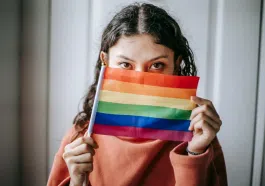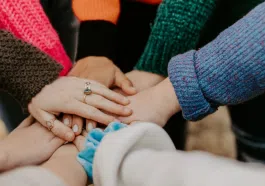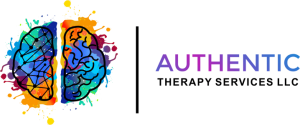The concept of gender transcends traditional binaries. One term that has gained increasing recognition is “genderqueer.” This blog post aims to delve into the meaning of genderqueer, shedding light on its significance within the LGBTQ+ community and beyond.
The gender binary: what is it?
A gender binary view holds that only two types of people exist – men and women.
In contrast, many people understand gender as a spectrum instead of a binary. Those who identify differently on that spectrum can fall anywhere along it – or place differently entirely.
The concept of sex is aligned with gender identity for some people. The term cisgender refers to this. Some people do not align gender and sex. The term transgender (trans) describes this.
What is the difference between sex and gender?
Many people confuse “sex” with “gender,” but the two terms have different meanings:
- In biology, sex refers to the physical characteristics that allow males, females, and intersex people to be differentiated from one another.
- A person’s gender reflects their identity and how they feel inside. Different types of genders exist, such as male, female, nonbinary, agender, and many more. An individual’s gender identity may differ from their birth sex.
Defining Genderqueer
Genderqueer is an umbrella term used to describe individuals whose gender identity does not conform to conventional expectations of male or female. It is an expansive and inclusive term that recognizes the fluidity and diversity of gender experiences. Those who identify as genderqueer may embrace a non-binary identity, rejecting the notion of being solely male or female.
They may also identify as a combination of male and female genders or as something else entirely. Genderqueer individuals may use a variety of pronouns, such as they/them, to express their gender identity.
Embracing Fluidity and Non-Binary Identities
One of the critical aspects of genderqueer is the recognition and celebration of fluidity. Genderqueer individuals may experience their gender identity as a spectrum, encompassing elements of both masculinity and femininity or existing outside of those constructs altogether. This fluidity challenges societal norms and encourages a more nuanced understanding of gender.
Genderqueer individuals reject the idea that gender is static and binary. Instead, they embrace a more nuanced understanding of gender that acknowledges the diversity of human experience. This understanding can help to foster more inclusive and supportive spaces for genderqueer individuals.
Other Identities
In addition to genderqueer and nonbinary identities, several other identities fall under this umbrella. Examples include:
- Agender: Someone who is agender does not have a gender identity or has a neutral gender identity. In addition to gender, people may also identify as genderqueer or nonbinary.
- Bigender: A bigender is a person who has two genders.
- Demigender: Demigender people identify partially with a particular gender.
- Genderfluid: Non-fixed gender identities that change over time or according to context
- Gender neutral: Those who do not identify as having a gender or as having a neutral gender may use the terms neutrois and gender neutral.
- Pangender: A non-binary identity that encompasses multiple genders.
Additionally, people of any gender can have any sexual orientation.
What is the difference between genderqueer and nonbinary?
There is often overlap between genderqueer and nonbinary identities. A debate exists about what the difference is between the two.
A nonbinary person tends to be someone who does not identify with a man or woman in a binary sense. Under that umbrella, genderqueer is often used to describe the feeling that one’s gender is fluid.
In recent years, genderqueer identity has expanded to encompass anyone who “queers” gender. It describes anyone who behaves differently from what is expected of them regarding their perceived or actual gender identity.
This second framework could encompass a much broader definition of genderqueer than nonbinary since many of us do things that don’t seem normal to people of our gender identity.
Considering that genderqueer includes queer, and queer identity has a particular political bent, being genderqueer can have a specific political tendency that nonbinary people may or may not share.
It is up to each individual to decide which terms are most suitable for them.
Navigating Language and Pronouns
Language plays a vital role in acknowledging and respecting genderqueer individuals. Some may prefer gender-neutral pronouns such as they/them, while others may choose neopronouns like ze/hir or ey/em. It is essential to use individuals’ preferred pronouns to foster inclusivity and support their gender identities.
What pronouns do genderqueer people use?
Genderqueer and nonbinary people do not use the same pronouns. Here are some examples of pronouns people might use:
Gender Neutral Pronouns
The singular they is one of the most common pronouns used by nonbinary people. Unlike “he” or “she,” “they” is used instead of “him” or “her.” Lastly, “theirs” is used instead of “his” or “hers.”
A person with both he/him/his and they/them/theirs pronouns feel comfortable being addressed as he/him/his and they/them/theirs.
Gendered Pronouns
Depending on the person’s current identity or expression, some genderqueer people may use only “she/her/hers” and “he/him/his.”
Neopronouns
Nonbinary people sometimes use neopronouns. Several pronouns do not exist in the language of nonbinary people, such as “ze/hir/hirs,” “fae/faer/faers,” and “xe/xem/xirs.” In neopronouns, “X”s are usually pronounced “Z.” Make sure to ask a nonbinary person how to pronounce their pronouns.
For more about pronouns, read our article Embracing Gender Pronouns: A Step Towards Inclusivity.
Genderqueer Intersectionality
Experiences of gender queerness intersect with racial, ethnic, and socioeconomic identities. It is crucial to recognize these intersections better to understand genderqueer individuals within different communities and their challenges.
Genderqueer individuals may face discrimination or oppression due to gender expression or identity. It is essential to create safe spaces for genderqueer individuals and policies to protect them from discrimination. It is also necessary to work to end gender stereotypes and to create more inclusive, equitable, and diverse societies.
Takeaway
Genderqueer is an empowering and inclusive term that challenges traditional notions of gender. We can create a more inclusive and understanding society by embracing fluidity, rejecting binaries, and advocating for respectful language. Understanding the meaning of genderqueer is a step towards fostering acceptance and support for all individuals, regardless of their gender identity.














